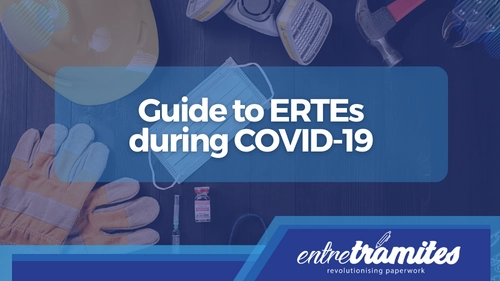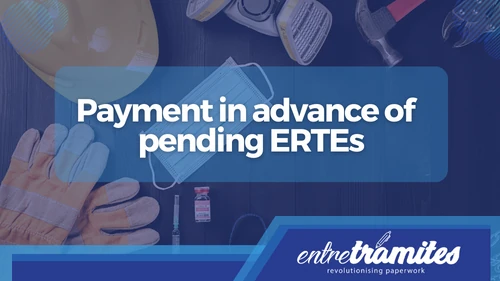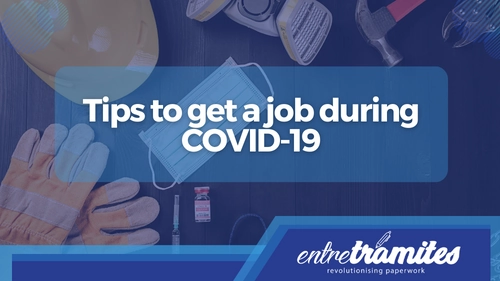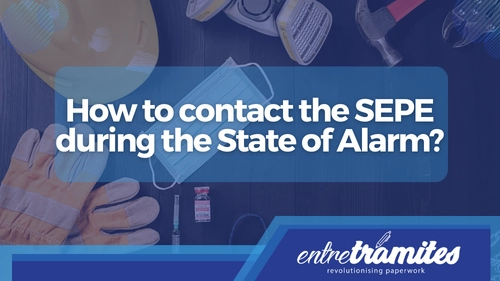Below we bring you a complete guide to questions and answers about ERTEs during the coronavirus crisis and the State of Alarm. Can an ERTE become an ERE? Is the company obliged to negotiate with the workers? Will I get paid the same while I am unemployed? We resolve the main doubts related to temporary lay-offs. Here’s a video tutorial on how to check the status of your unemployment benefit.
What is an ERTEs during the coronavirus and what does it mean for the worker?
An Expediente de Regulación de Empleo Temporal (Temporary Employment Regulation File or ERTE) allows the employer to suspend the employment contract of all or part of its employees for economic, technical, organisational or production reasons, or due to force majeure. The worker affected by an ERTE becomes unemployed for the period of time set by the company. They are not entitled to compensation, but they are entitled to unemployment benefits. An ERTE is approved with a maximum period of application, but the company is free to shorten it or not apply it according to its needs.
What peculiarities does an ERTE due to force majeure have?
When the ERTE is due to force majeure (i.e. when an unavoidable event occurs that makes the continuity of an employment relationship impossible for all purposes), it has a reduced processing period (5 days) and does not require negotiation with the trade unions (as ERTE due to economic causes does). It does have to be authorised by the labour authority. This type of ERTE is the one that will be applied in many companies affected by the coronavirus crisis, specifically in those affected by “suspension or cancellation of activities, temporary closure of public places, restrictions on public transport and, in general, on the mobility of people and/or goods, lack of supplies that seriously impede the continuation of the ordinary development of the activity, or in urgent and extraordinary situations due to the contagion of the workforce or the adoption of preventive isolation measures decreed by the health authority”.
Will I receive unemployment benefits even if I have not yet contributed for a year?
Yes, for the ERTEs that are motivated by the coronavirus crisis, the Government has stipulated that all workers affected by ERTEs will have access to the benefit regardless of the time they have contributed. In addition, the time spent in unemployment will not be subtracted from their accumulated rights, i.e. at the end of the ERTE, their ‘counter’ will be reset to zero.
Can the ERTE be a reduction in working hours, and is unemployment paid in this case?
Yes, it is one of the two types of ERTE (the other is a suspension of contracts, in which employees stop working). The company stipulates what percentage of reduction it needs to apply depending on the drop in activity suffered and the worker will receive his salary proportional to the hours he works and, to complement it, he may request unemployment benefits to cover the remaining part of the day. However, this benefit does not allow you to obtain income equivalent to the full salary, but rather 70% of it. For example, if the ERTE involves a 60% reduction in the working day, you will only receive 70% of the 60% of the salary corresponding to the reduced hours for unemployment and, on the other hand, you will continue to receive the other 40% of your salary for the hours worked.
Will I receive the same amount in unemployment as I would if I were working?
No. During the first 180 days of unemployment, you will receive, at most, 70% of your contribution base, with a maximum of: 1,098.09 euros if you do not have children, 1,254.96 euros if you have a child and 1,411.83 euros if you have two or more children. After having spent 180 days unemployed, you will collect 50% of your contribution base.
Does the company have to continue paying the contributions of its employees?
Yes, it has to be done in the case of ERTE for economic, technical, organizational or production reasons. If the ERTE is due to force majeure linked to the coronavirus crisis, the Government exempts the company from paying 75% of the business contribution to Social Security, with said exemption reaching 100% of the quota in the case of companies. of less than 50 workers, as long as they commit to maintaining employment for at least six months after resuming activity.
Can an ERTE be converted into an ERE?
No. They are different measures and each one has its own procedure. Moreover, if the company has implemented an ERTE due to force majeure and has benefited from the exemption from the payment of social security contributions, it will be subject to the commitment to maintain employment for a period of six months from the date of the resumption of activity.
Is the company obliged to negotiate with the workforce?
A negotiation period is only opened in the case of ERTE for economic, technical, organizational or production reasons. However, given the extraordinary circumstances involved in this crisis, the Government has reduced this negotiation period to a maximum of 7 days. A maximum period of 5 days is given to establish the negotiating commission. On the other hand, there is no obligation to reach an agreement with the workers during this consultation period: at the end of it, the decision rests with the company.
In the case of ERTEs due to force majeure, there is no negotiation period: the company will directly present the request to the staff and the workers’ representatives, accompanied by a report relating to the link between the loss of activity as a result of the COVID-19. The labour authority will be in charge of verifying the existence of this cause of force majeure and resolving the request and may request a report from the Labor and Social Security Inspection if it deems it appropriate.
Can workers challenge an ERTE?
Yes. Workers can file a claim in court within 20 business days of the company’s notification. If the judge decides that the ERTE is not valid, the workers must be restored to their previous conditions, and the company must pay the unpaid salary differences due to the suspension or reduction in working hours.
What steps must be followed to present an ERTE?
If it is an ERTE for economic, technical, organizational or production reasons:
- The first thing is to reliably communicate to workers your intention to start an ERE. From this communication, the workers have a period of five days to establish their negotiating committee.
- Once the negotiating committee has been established, the company sends a communication of the beginning of the consultation period to the workers and the competent Labor Authority. This communication must include:
- Causes that motivate the suspension or reduction of working hours.
- Number and professional classification of workers who will be affected.
- Number and professional classification of workers usually employed in the last year.
- Concretion and detail of the measures to suspend contracts or reduce working hours.
The consultation period will last a maximum of 7 days and at least two meetings must take place. The corresponding minutes must be drawn up for each meeting with the signatures of all attendees.
3. Once the consultation period has ended, the company must notify the workers and the Labor Authority of its decision on the reduction or suspension.
If it is an ERTE due to force majeure:
- The procedure will be initiated by request of the company. This request must be communicated to the staff and to the worker’s representatives, in addition to the labour authority.
- The labour authority must decide within a maximum period of 5 days whether there is actual justification for the ERTE (it may request a report from the Labor Inspection, which must issue it within a maximum period of 5 days). The absence of a response is equivalent to a positive response.
How is unemployment benefit processed with an ERTE?
Workers who are affected by a Temporary Employment Regulation File (ERTE) caused by the coronavirus health alert do not have to request an appointment with the Servicio Publico de Empleo Estatal (State Public Employment Service or SEPE), since the management of their benefit will be processed accordingly. trade between your company and this organization.
For its employees to collect unemployment benefits, the company must make two notifications from the Certific@2 application, on the website of the State Public Employment Service (www.sepe.es):
- The company certificates contain the contribution bases for the last 180 days contributed by each worker.
- The exact dates on which the worker has the contract suspended or the working day reduced.
Do you need more information about unemployment benefits?
We want to listen to you and know what your questions are about the procedures you have to carry out. Count on the advice of our experts to clarify all your doubts.
At Entre Trámites we invite you to learn about our services. Fill in our contact form and we will call you to help you as soon as possible, schedule a free online consultation, or simply text our WhatsApp.





